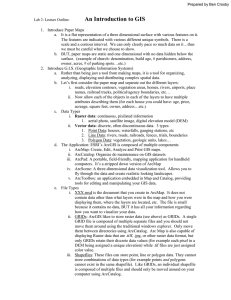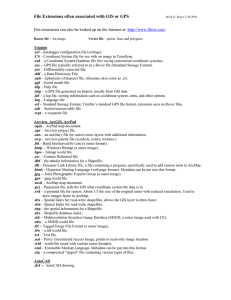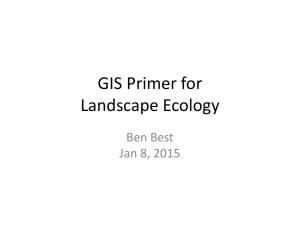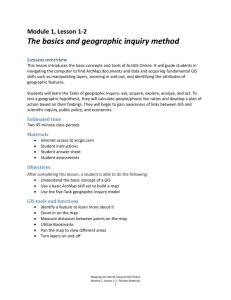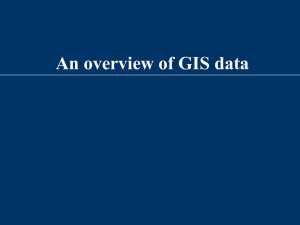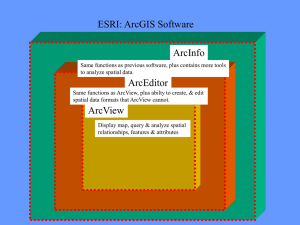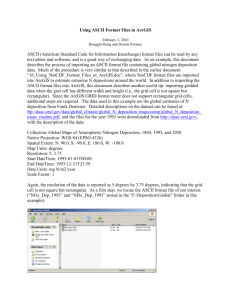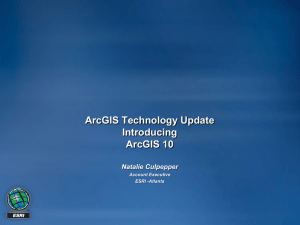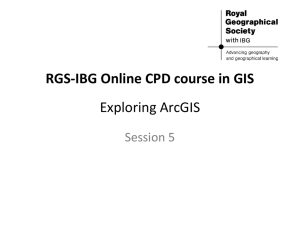Marine GIS Applications using ArcGIS Global
advertisement
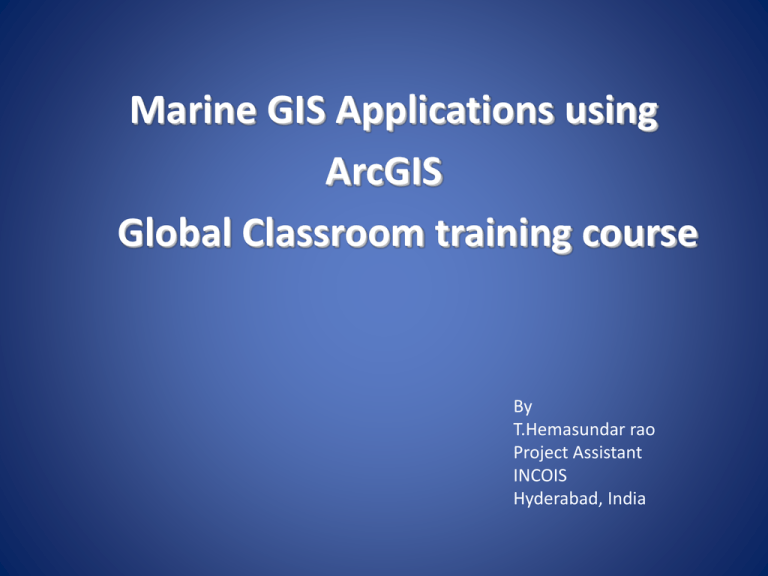
Marine GIS Applications using ArcGIS Global Classroom training course By T.Hemasundar rao Project Assistant INCOIS Hyderabad, India Introduction Geographic Information Systems (GIS) It is an integrated set of hardware and software tools used for the capture, storage, analysis and display of geographic data. GIS technology integrates common database operations such as query and statistical analysis with the visualisation and geographic analysis benefits offered by maps and charts ArcGIS It is a complete system for authoring, serving, and using geographic information. It is an integrated collection of GIS software products for building and deploying a complete GIS. Introduction to ArcGIS ArcGIS Desktop contains a suite of software applications for conducting GIS work: ArcMap is the main application in ArcGIS and is used for all mapping and editing tasks as well as for map-based query and analysis. ArcCatalog helps users organize and manage all geographic information, such as maps, globes, data files, geodatabases, geoprocessing toolboxes, metadata, and GIS services. ArcToolbox is a collection of geoprocessing tools Data Viewing in ArcMap Base Map Creation Map Projections and Coordinate Systems Coordinate systems : Coordinate systems are used for georeferencing used in precise positioning, navigation, and geographic information systems for the location of points in space. There are two types of coordinate systems: Geographic Projected Map projection : “A map projection is any method of representing the surface of a sphere or other three-dimensional body on a plane” Map Projections and Coordinate Systems Interpolation in ArcGIS ArcGIS Spatial Analyst extension provides tools for spatial data analysis that apply statistical theory and techniques to the modeling of discrete spatially referenced data ArcGIS Spatial Analyst uses Inverse Distance Weighted (IDW), Kriging, Spline Polynomial Trend, and Natural Neighbor interpolation methods to estimate depth, temperature, rainfall, contamination concentrations or other spatially continuous phenomena Interpolating surfaces Rendering Raster Data A raster dataset layer is added to ArcMap, it is displayed using the default renderer most appropriate for the raster layer. ArcMap allows you to choose from different drawing methods based on your display and analysis needs. You can change display colours, group data values into classes, or stretch values to increase the visual contrast. Rendering Raster Data Raster Calculator The Raster Calculator, which is part of the Spatial Analyst extension, provides a powerful tool for performing mathematical calculations using operators and functions, set up selection queries, or type in Map Algebra syntax. Inputs can be raster datasets or raster layers, coverages, shapefiles, tables, constants, and numbers. Raster Calculator Working with NetCDF NetCDF is a set of self-describing, machine-independent data formats that support the creation, access, and sharing of array-oriented scientific data. It is a file format for storing multidimensional scientific data (variables) such as temperature, humidity, pressure, wind speed, and direction.The project homepage is hosted by theUnidata program at the University Corporation for Atmospheric Research (UCAR). Working with NetCDF Plotting Vector Arrows from U and V Component Grids ArcMap can be used to generate motion vector arrows from U and V component grids for ocean currents and wind data to plot speed and direction vectors. A useful tool for visualizing quiver plots can be found in the MGET toolbox which can be accessed as a toolbox in ArcToolbox. Plotting Vector Arrows from U and V Component Grids Creating KML files for Google Earth KML is a file format used to display geographic data in an earth browser, such as Google Earth and Google Maps. A KML file specifies a set of features (place marks, images, polygons, 3D models, textual descriptions, etc.) for display in Google Earth and Google Maps, or any other geobrowser implementing the KML encoding. Each place always has a longitude and a latitude. Other attribute data can also be included. KML files are very often distributed in KMZ files, which are zipped files with a .kmz extension. KML files for Google Earth Publication Quality Maps ArcMap has the capability to create a map for printing or inclusion in another document using the Layout View.The final map can include the map itself, a title, a legend, a scale, a north arrow, date of publication, and acknowledgements about data sources. Quality Maps Publication
